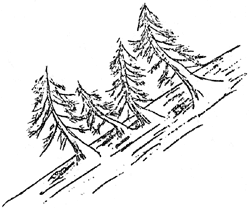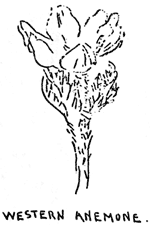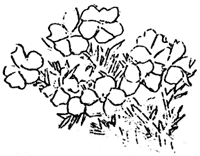The Fruiting Bodies of Slime Molds
By Frederick L. Wynd
In the earlier part of the season during the time when the snow is melting in the deep woods just below the Rim, the fruiting bodies of the slime molds may be found in great numbers on the ground and on rotten logs. They are usually about one-half inch in diameter and are bright orange in color which makes them very conspicuous and easily identified. The spores are borne in great numbers in the interior of the mass.
The great group of slime molds are among the most interesting plants in existence, and their strange life history should be more commonly known. During certain stages they show the characteristics of animals, and in other stages they appear as typical plants.
In the evolutionary scheme of things in which we regard the plants and animals as having a common ancestry, we would expect to find forms of life which are not clearly differentiated into either. The slime molds are among these “missing links” that connect the two great classes of life.
Identity?
By C. L. Croghan, Park Ranger
While putting things away for the winter at Anna Springs last November, a young pine squirrel was noticed, very busily engaged in stowing away his winter supply of pine cones. On closer observation it was discovered that this squirrel had different markings than the ordinary pine squirrel. It was thought possible that this could be due to its immaturity.
This summer it was again observed working around various trees and dwellings. The body is more slim than that of the ordinary pine squirrel of the Castle Creek area. The coat, while of about the same color on the back, is distinctly a more golden brown underneath. The tail has a white tip rather than the usual black; and the fur along the edges of the tail is of grayish color instead of brown and black.
Tree Curvature
By L. D. Leslie, Ranger-Naturalist
A majority of the trees growing on the steep moraines of old Mount Mazama have a pronounced curvature at their base. So prominent is this bending that many tourists wonder at the phenomenon.
The Early Flowers
By Frederick L. Wynd
The early blooming flowers are usually small and inconspicuous. This may be because they are generally those species that rely largely on the food which they have stored during the previous season. Food which has been so carefully hoarded over the winter is not to be wasted in producing needlessly large plant bodies. If one is observant, however, he may even at this early part of the season find an abundant number of species in bloom.
The following list has been identified from near the Rim and Government Camp before July 1st, and these are the species which the tourist may expect to see at this time of the year:
Clintonia uniflora (Schult.) Kunth.
Vagnera amplexicaulis (Nutt.) Greene.
Limnorchis stricta (Lindl.) Rydb.
Limnorchis dilatata (Pursh) Rydb.
Salix sitchensis Sanson
Salix eastwoodiae Cockerell
Salix scouleriana Barratt
Alnus sinuata (Regel) Rydb.
Eriogonum umbellatum Torr.
Polygonum newberryi Small
Spraguea umbellata Torr.
Claytonia lanceolata Pursh
Anemone drummondii Wats.
Pulsatilla occidentalis (Wats.) Froyn.
Ranunculus gormanii Greene
Ranunculus eschscholtzii Schlecht.
Bicuculla formosa (Andr.) Coville
Bicuculla uniflora (Kellogg) Howell
Parrya menziesii (Hook.) Greene
Ribes erythrocarpum Cov. & Leiberg
Ribes cereum Dougl.
Ribes viscosissimum Pursh
Ribes lacustre (Pers.) Poir.
Potentilla glandulosa Lindl.
Prunus emarginata (Dougl.) Walp.
Amelanchier florida Lindl.
Ceanothus prostratus Benth.
Ceanothus velutinus Dougl.
Viola purpurea Kellogg
Viola glabella Nutt.
Viola praemorsa Dougl.
Arctostaphylos nevadensis Greene
Arctostaphylos patula Greene
Kalmia glauca microphylla Hook.
Vaccinium scoparium Leiberg
Vaccinium membranaceum Dougl.
Phlox douglasii Hook.
Polemonium viscosum elegans
Lapulla diffusa (Lehm.) Greene
Valeriana sitchensis Bong.
Agoseris alpestris (Gray) Greene
***previous*** — ***next***




